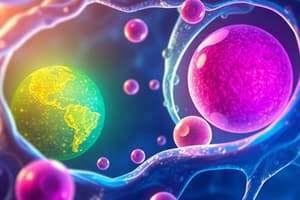Podcast
Questions and Answers
What is the process of water movement through a semipermeable membrane called?
What is the process of water movement through a semipermeable membrane called?
- Diffusion
- Filtration
- Capillarity
- Osmosis (correct)
What happens to the water in potato cup B after adding sugar?
What happens to the water in potato cup B after adding sugar?
- Water leaves the cup.
- Water enters the hollowed section. (correct)
- Water evaporates.
- Water freezes.
Why is potato cup A important in the osmosis experiment?
Why is potato cup A important in the osmosis experiment?
- To observe the effects of salt.
- To serve as a control with no solute. (correct)
- To provide additional nutrients.
- To be a comparison for the other cups.
What prevents osmosis from occurring in potato cup A?
What prevents osmosis from occurring in potato cup A?
What occurs in potato cup C after the addition of salt?
What occurs in potato cup C after the addition of salt?
What is a characteristic of prokaryotic cells?
What is a characteristic of prokaryotic cells?
Which statement distinguishes plant cells from animal cells?
Which statement distinguishes plant cells from animal cells?
What is NOT a feature of eukaryotic cells?
What is NOT a feature of eukaryotic cells?
How do amoebas obtain their food?
How do amoebas obtain their food?
Which difference is true regarding the size of prokaryotic and eukaryotic cells?
Which difference is true regarding the size of prokaryotic and eukaryotic cells?
Which of the following is found in eukaryotic cells but absent in prokaryotic cells?
Which of the following is found in eukaryotic cells but absent in prokaryotic cells?
What is a common feature of animal cells?
What is a common feature of animal cells?
What mechanism separates daughter cells in plant cell division?
What mechanism separates daughter cells in plant cell division?
Which organelles contain their own genetic material?
Which organelles contain their own genetic material?
Why is the plasma membrane considered selectively permeable?
Why is the plasma membrane considered selectively permeable?
Who was the scientist that first discovered cells?
Who was the scientist that first discovered cells?
What occurs if the organization of a cell is severely damaged?
What occurs if the organization of a cell is severely damaged?
Why are lysosomes referred to as 'suicide bags'?
Why are lysosomes referred to as 'suicide bags'?
What happens if the plasma membrane is ruptured?
What happens if the plasma membrane is ruptured?
What is the primary function of the Golgi apparatus in a cell?
What is the primary function of the Golgi apparatus in a cell?
What role do ribosomes play in a cell?
What role do ribosomes play in a cell?
What is the primary function of the Golgi apparatus?
What is the primary function of the Golgi apparatus?
Why are mitochondria referred to as the powerhouse of the cell?
Why are mitochondria referred to as the powerhouse of the cell?
Where are lipids that compose the cell membrane synthesized?
Where are lipids that compose the cell membrane synthesized?
How do CO2 and O2 typically move in and out of cells?
How do CO2 and O2 typically move in and out of cells?
Which characteristic distinguishes prokaryotic cells from eukaryotic cells?
Which characteristic distinguishes prokaryotic cells from eukaryotic cells?
What type of endoplasmic reticulum is responsible for producing proteins for the cell membrane?
What type of endoplasmic reticulum is responsible for producing proteins for the cell membrane?
What happens to the concentration of CO2 during respiration inside the cell?
What happens to the concentration of CO2 during respiration inside the cell?
What do prokaryotic cells lack that eukaryotic cells possess?
What do prokaryotic cells lack that eukaryotic cells possess?
Flashcards are hidden until you start studying
Study Notes
Fundamental Unit of Life: Key Concepts
-
Organelles with Genetic Material: Chloroplasts and mitochondria have their own DNA, distinguishing them from other organelles.
-
Site of Protein Synthesis: Proteins are synthesized in ribosomes, which can be found either free in the cytoplasm or attached to the rough endoplasmic reticulum.
Discovery of Cells
- Robert Hooke: An English scientist who discovered cells in 1665 using a self-designed microscope to observe cork.
Celular Structure and Function
-
Cell as a Unit of Life: Cells are the foundational building blocks of all living organisms, responsible for all life processes.
-
Plasma Membrane: Characterized as selectively permeable, made of lipids and proteins, controlling the entry and exit of molecules.
-
Cell Death Mechanism: If a cell’s organization is disrupted, lysosomes can release digestive enzymes, leading to cellular self-digestion and death.
-
Lysosomes: Known as "suicide bags," they contain hydrolytic enzymes for digestion, which can also lead to cell destruction if released.
Importance of Golgi Apparatus
- Role of Golgi Apparatus: Essential for the modification, packaging, and transport of cellular materials. Without it, cells cannot effectively manage biochemical substances.
Energy Production
- Mitochondria: Known as the powerhouse of the cell, they generate ATP through respiration, crucial for cellular energy.
Membrane Components
- Synthesis of Cell Membrane Components:
- Smooth Endoplasmic Reticulum (SER): Synthesizes lipids.
- Rough Endoplasmic Reticulum (RER): Contains ribosomes for protein synthesis.
Gas Exchange Mechanism
- Diffusion of Gases: CO2 and O2 move across cell membranes through diffusion, with CO2 being produced in respiration and O2 consumed.
Prokaryotic vs. Eukaryotic Cells
-
Prokaryotic Cells: Typically smaller (1-10μm), have no defined nuclear membrane, single chromosome, and lack membrane-bound organelles.
-
Eukaryotic Cells: Generally larger (5-100μm), possess a well-defined nuclear membrane, multiple chromosomes, and contain membrane-bound organelles.
Plant Cells vs. Animal Cells
- Structural Differences:
- Plant Cells: Have a cell wall, plastids, large vacuoles, and form daughter cells via cell plate.
- Animal Cells: Lack a cell wall, no plastids, smaller vacuoles, and form daughter cells by constriction.
Feeding Mechanism
- Amoeba Feeding: Uses pseudopodia to envelop planktonic bacteria and forms a food vacuole for digestion.
Osmosis Explained
- Definition of Osmosis: Movement of water through a semipermeable membrane from high to low water concentration, crucial for cellular processes.
Osmosis Experiment with Potatoes
- Observation of Osmosis: Adding sugar or salt creates a hypertonic solution that draws water into the potato cups (B and C).
- Control: Cup A serves as a control to demonstrate osmotic differences, while cup D (boiled potato) shows altered permeability but no osmotic effect.
Expectations from the Experiment
- Water Accumulation Reasons: Occurs in cups containing sugar or salt due to the osmotic pressure.
- No Water Accumulation: In cups A and D, due to lack of a solution to facilitate osmosis.
These notes capture the key elements and concepts from the Chapter on the Fundamental Unit of Life, essential for Class 9 Science students.
Studying That Suits You
Use AI to generate personalized quizzes and flashcards to suit your learning preferences.





